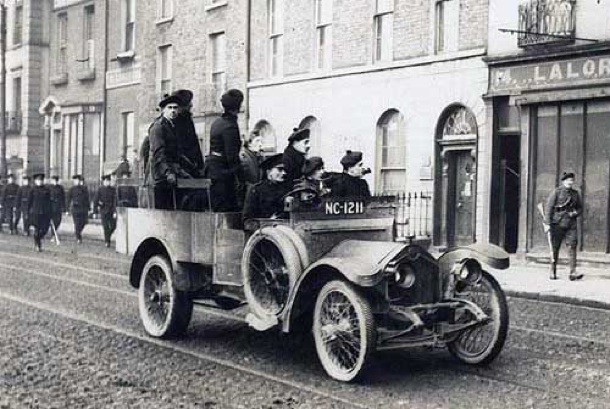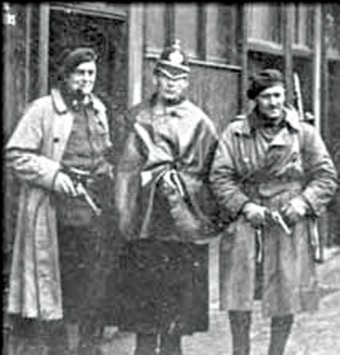13 November 2013
War over 'Black and Tans memorial' at Kilmichael

The hated Black and Tans in a Crossley tender
‘The British don’t commemorate the Black and Tans because they are not proud of the appalling reputation they earned in Ireland’
ON 24 NOVEMBER 1920, a unit of IRA Volunteers under the command of Tom Barry wiped out a squad of Auxiliaries in an ambush at Kilmichael. It was one of the most decisive operations of the Tan War and shattered the morale of the Black and Tans in Munster.
Three IRA Volunteers were killed in the operation after a false surrender by the surrounded enemy combatants.
It is widely accepted that the current memorial is in need of redevelopment and two local historical societies – the Kilmichael Historical Society and the Kilmichael & Crossbarry Commemorative Committee – have applied for planning permission to do just that. But a report that the site will include a memorial or “acknowledgement area” to the 17 British terrorists killed there has caused public outrage.

Both historical groups deny that Black and Tans (pictured with a policeman) will be commemorated.
In the application lodged with Cork County Council, though, it states very clearly that it aims to be a “suitable commemoration for both IRA Volunteers and Auxiliaries” including a plaque naming the Black and Tans killed.
A sketch map of the ambush site submitted alongside this planning application includes a “skeleton of a 1920 Crossley Tender” (2.2metres high and 5m in length), the troop transport used by the British troops terrorising Irish towns and villages. “This will be used to reference the involvement of the British troops and the struggle posed upon them,” says the submission.
Seán Kelleher of the Commemorative Committee said the Crossley tender will not be included, despite planning permission being approved for it, and also said nobody at all will be named on the monument, neither IRA Volunteers nor Black and Tans.
In one article in The Southern Star newspaper, resident columnist Archon wrote:
“Would the British erect a memorial to the German aviators who indiscriminately slaughtered men, women and children in bombing raids on Britain during the Second World War? Of course not! Our neighbours are not that mad or sufficiently brainwashed to debase or dishonour their history. Sadly, on this side of the pond things are different.”
Reacting to the proposal, noted historian and author Pádraig Óg Ó Ruairc said:
“Surely it is wrong for semi-state bodies to spend public money commemorating those who fought to prevent the emergence of an Irish state, and sought to deny Irish people what we now accept are fundamental democratic rights?”
He went on to note that even the British do not commemorate the Black and Tans.
“The British don’t commemorate these troops because they are not proud of the appalling reputation they earned in Ireland.”
Alarm bells have also been ringing after Ian Doyle of the Heritage Council suggested that the new installation should “achieve a balanced interpretation of what happened at Kilmichael that reflects modern scholarship of the ambush”.
This seems to be a reference to Canadian historian Peter Hart’s account in his book,The IRA and Its Enemies, which claims the IRA executed unarmed Auxiliary prisoners after the ambush. This revisionist report has been widely dismissed after it emerged that Hart claimed he was told the information by two surviving IRA members in 1988 – at a time when only one survivor of the attack was alive and who did not speak to Hart.
Tony McCarthy, a member of the Timothy Kenefick Commemoration Committee, has criticised the plans “to erect memorials for the forces who oppressed our people’s desire to establish an independent Republic would bring shame, not alone to the dead Volunteers of Kilmichael but also to the countless numbers of men and women in every generation who fought to substitute the name of Catholic, Protestant and Dissenter by the common name of Irishmen and women.”
The National Graves Association says “questions still need to be answered in relation to the planning permission granted for the redevelopment of the ambush site”.
It seems that the fog of war still surrounds this controversial episode.
☛ In their own words . . .
Divisional Commander Lt-Col Smyth, June 1920
❛ If a police barracks is burned or if the barracks already occupied is not suitable, then the best house in the locality is to be commandeered, the occupants thrown into the gutter. Let them die there – the more the merrier.
❛ Should the order [“Hands up”] not be immediately obeyed, shoot and shoot with effect. If the persons approaching [a patrol] carry their hands in their pockets, or are in any way suspicious-looking, shoot them down. You may make mistakes occasionally and innocent persons may be shot but that cannot be helped, and you are bound to get the right parties some time.
❛ The more you shoot, the better I will like you, and I assure you no policeman will get into trouble for shooting any man.❜
Follow us on Facebook
An Phoblacht on Twitter
Uncomfortable Conversations

An initiative for dialogue
for reconciliation
— — — — — — —
Contributions from key figures in the churches, academia and wider civic society as well as senior republican figures





